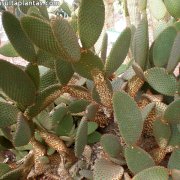Care of the cactus Opuntia rufida or Blind Prickly Pear |
|
The genus Opuntia, family Cactaceae, includes some 300 species of cacti originating in Mexico, the USA and Central and South America. Some species are: Opuntia rufida, Opuntia robusta, Opuntia polyacantha, Opuntia microdasys, Opuntia linguiformis, Opuntia leucotricha, Opuntia engelmannii, Opuntia bergeriana, Opuntia santa-rita, Opuntia ficus-indica, Opuntia aciculata, Opuntia durangensis, Opuntia subulata, Opuntia lindheimeri, Opuntia basilaris, Opuntia atrispina, Opuntia phaeacantha, Opuntia auberi, Opuntia valida, Opuntia macrocentra, Opuntia chlorotica, Opuntia vestita, Opuntia spinulifera. Common names: Blind Prickly Pear, Cactus red bunny ears, Cinnamon bunny ears, Cinnamon pear, Clock face cactus, Cow blinder, Blind Pricklypear. Scientific synonyms: Opuntia herfeldtii, Opuntia lubrica. This species is native to northern Mexico and Texas. They are highly branched, shrubby cacti that can reach 1.5 meters (4.92 feet) in height. The segments are greenish-gray in color, circular in shape and velvety in texture. They have numerous round areolas, without spines, arranged diagonally and with reddish glochids. The flowers are orange or yellow and measure 5 cm (1.96"). They bloom in summer. They produce red fruits. Blind Prickly Pear is used to form groups and barriers in dry areas of the garden, as isolated specimens, in rockery and in pots. Opuntia rufida needs full sun exposure and high temperatures. The winter safety temperature is 5 ºC (41 ºF). The soil can be a mixture, in the same proportions, of leaf mulch and coarse sand. Transplant in spring if the roots show below the container. Cinnamon bunny ears resists drought very well; water moderately in spring and summer waiting for the substrate to be dry. Reduce watering in fall and do not water in winter. Fertilize with mineral cactus fertilizer once in spring and once in summer. Clock face cactus does not need pruning. Opuntia rufida is very resistant to diseases and drought but not to excess water. Blind Prickly Pear is easily propagated from segment cuttings rooted in slightly damp sandy substrate. |
Images of the cactus Opuntia rufida or Blind Prickly Pear |
Find plants
Opuntia rufida or Blind Prickly Pear | Care and Growing
© 2026 FavThemes

